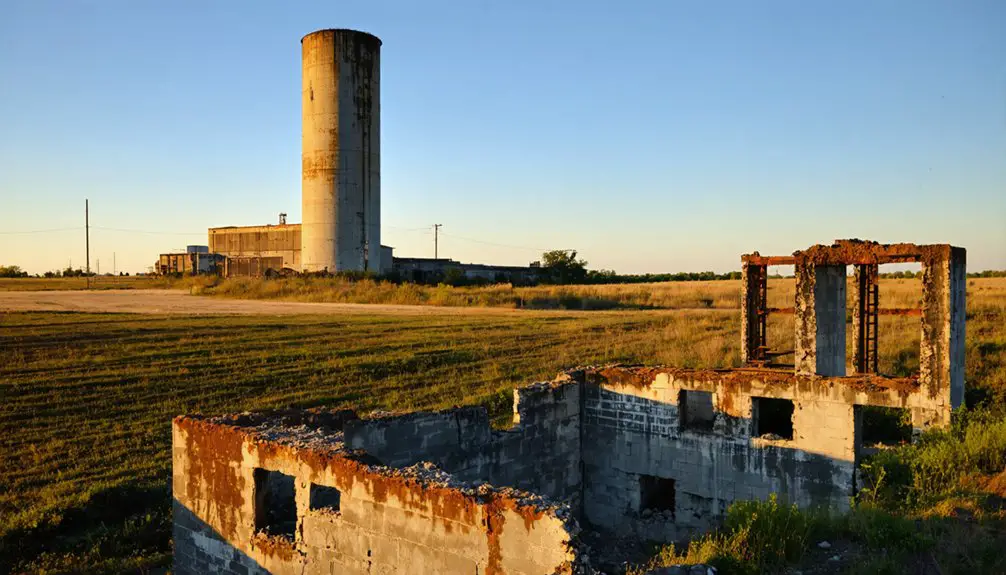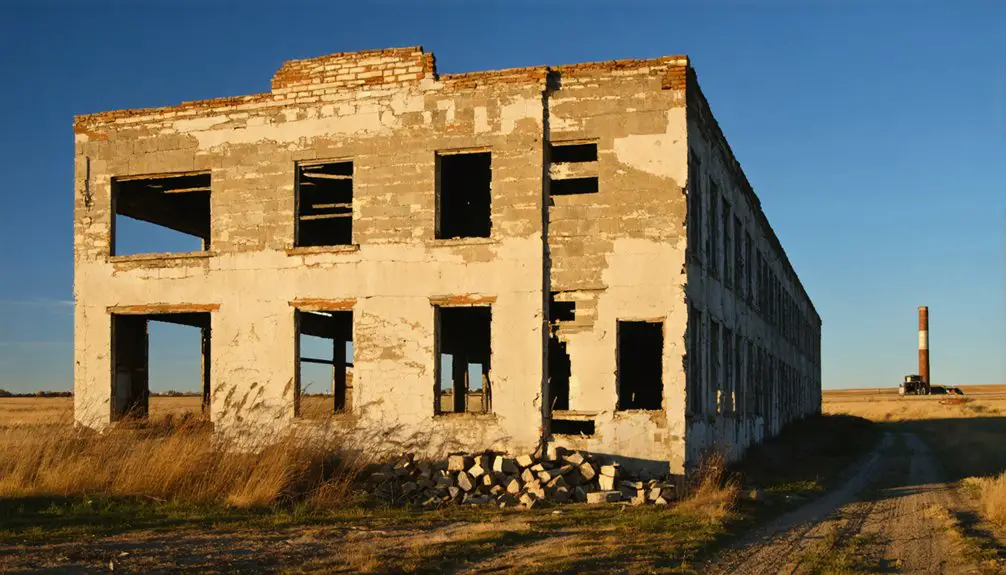You’ll find the remnants of Yocemento along U.S. Highway 40, northwest of Hays, Kansas, where weathered limestone walls stand as silent sentinels to a forgotten industrial dream. Founded in 1906, this Hungarian immigrant community thrived briefly as home to the largest cement plant west of the Mississippi. Though the plant closed in 1917, scattered houses and crumbling industrial ruins still dot the landscape, each stone telling tales of ambitious dreams and immigrant determination.
Key Takeaways
- Yocemento, Kansas was established in 1906 as a cement production town, powered by Hungarian immigrant workers and the United States Portland Cement Company.
- The town flourished briefly from 1908-1917, featuring a church, general store, hotel, and post office serving its 75 resident workers.
- The cement plant’s closure in 1917 led to Yocemento’s decline, with the facility dismantled by Boettcher Company that same year.
- Today, weathered limestone walls of the former cement mill and scattered early 1900s homes are all that remain of the original town.
- The site has transformed from an industrial center to an agricultural hub, with Midland Marketing operating the most prominent modern structures.
The Birth of a Limestone Legacy
When Kansas state geologist Erasmus Haworth and businessman I. M. Yost surveyed the rugged terrain of western Kansas in 1906, they saw more than just a limestone ridge called Hog Back – they envisioned industrial innovation.
You’ll find their dream took shape as Yocemento, a town strategically positioned for limestone extraction and cement production.
They couldn’t have picked a better spot. The site boasted rich Fort Hays Limestone deposits, access to Big Creek’s water supply, and the Union Pacific Railroad’s crucial transportation link.
Their vision became reality when the cement plant operational began producing in mid-1908.
Hungarian Heritage and Early Settlers
The limestone quarries and cement plant of Yocemento drew a particular group of determined workers – Hungarian immigrants who’d shape the town’s early character.
These Catholic families brought their cultural identity to Ellis County, initially gathering for worship in private homes before building St. Agnes Church in 1906 west of Big Creek’s first bend.
You’ll find their immigrant contributions went far beyond manual labor. By 1910, the Hungarian community, which made up most of Yocemento’s 75 residents, supported a bustling general store, hotel, restaurant, and post office.
Their presence defined the town’s social fabric, with life revolving around shared traditions and faith. The town’s founder I.M. Yost established the cement operation with support from U.S. Portland Cement Company and local citizens.
While their exodus following the plant’s 1917 closure marked the beginning of Yocemento’s decline, their legacy endures in the stories of this Kansas ghost town.
Rise and Fall of the Portland Cement Empire

Founded in 1906 by Kansas state geologist Erasmus Haworth and businessman I. M. Yost, the United States Portland Cement Company transformed a limestone-rich bluff into a thriving industrial operation.
Two pioneering entrepreneurs harnessed Kansas limestone deposits to establish a major cement manufacturing enterprise in the American heartland.
You’ll find the site’s strategic location capitalized on natural resources, with gravity-fed limestone delivery and Union Pacific Railroad access driving cement production success. The facility contributed to the region’s massive growth, reaching over one million barrels monthly across the Kansas-Oklahoma gas belt by 1910.
- Peak operations employed 75 residents, mainly Hungarian immigrants
- Innovative cable lift system transported limestone from quarry to mill
- Coast-to-coast shipping capabilities via direct rail access
- Catholic church establishment showed workforce community strength
Life Along the Union Pacific Railroad
Beyond Yocemento’s cement operations, life along Kansas’s expanding railroad network shaped the region’s destiny throughout the 1860s and 1870s. You’d have witnessed the dramatic railroad expansion westward from Kansas City, transforming the landscape as tracks stretched toward Denver.
Communities sprouted wherever the railroad established division points, with Junction City’s roundhouse and workshops drawing settlers seeking opportunity. The railway was originally established as the Leavenworth, Pawnee and Western before evolving into the Kansas Pacific. The railway received federal authorization through the Pacific Railway Act.
Life wasn’t easy along these iron rails. You’d have faced scorching heat, dust storms, and bitter winters. Native American conflicts intensified after 1864, requiring armed security for mail transport and worker protection.
Yet the railroad’s presence created vibrant hubs of activity, where diverse groups of workers and settlers forged new communities. Towns like Lawrence and Salina flourished as vital links in this growing transportation network, connecting isolated prairie settlements to distant markets.
Ancient Traces and Native American Presence
Stretching back to the Early Ceramic Keith phase around 400 CE, Yocemento’s rich archaeological record reveals a vibrant indigenous presence along Big Creek.
You’ll find evidence of seasonal hunting camps where early peoples crafted tools and processed game, leaving behind fragments that speak to their resourceful ways of life.
- Stone tool production using heat-treated local materials like quartzite and flint
- Discovered ceramic shards, bone tools, and mussel shell middens showing archaeological significance
- Traditional hunting grounds shared by Pawnee, Kiowa, Comanche, and other Plains tribes
- Indigenous practices centered on bison hunting and seasonal migration patterns
From Cement Dreams to Oil Fields
When ambitious geologist Erasmus Haworth and businessman I.M. Yost founded Yocemento in 1906, they envisioned a thriving cement industry powered by local limestone deposits. Their U.S. Portland Cement Company quickly attracted Hungarian immigrants and produced high-quality cement used in Kansas City’s Union Station.
Yet you’ll find their dream was short-lived. Larger competitors denied Yocemento access to affordable coal, forcing an expensive shift to oil fuel from eastern Kansas wells. The abundant gas and oil fields discovered in Kansas around 1892 had transformed the state’s industrial landscape.
Despite dreams of industrial success, Yocemento’s cement plant fell victim to coal monopolies, forcing a costly switch to oil fuel.
Despite the region’s growing oil boom, the plant’s remote location and rising operational costs proved insurmountable. By 1917, the Boettcher Company dismantled the mill, sending workers elsewhere.
While Kansas emerged as America’s leading oil producer that year, Yocemento couldn’t capitalize on this change. Today, only concrete remnants and repurposed foundations remind you of this bold industrial venture.
Remnants of a Bygone Era

Though the cement plant’s industrial machinery fell silent in 1917, archaeological evidence reveals a rich tapestry of human activity at Yocemento spanning centuries.
Today, you’ll find remnants of multiple cultural transformations, from ancient Native American hunting camps to the industrial decline of the early 20th century. The area’s heritage lives on through physical landmarks and cultural touchstones. Like many Kansas towns affected by bad weather and minerals, Yocemento’s population dwindled as resources were depleted.
- The original cement mill equipment stands as a stark reminder of Yocemento’s industrial past
- St. Agnes Catholic Church, built by Hungarian immigrants, survives as a community hall in Buckey Township
- Early Ceramic period artifacts showcase indigenous tool-making and hunting practices
- The original townsite’s layout remains visible along U.S. Highway 40, marking where dreams of industrial prosperity once flourished
The Last Traces of Yocemento Today
As you explore Yocemento today, you’ll spot concrete walls and foundations from the old cement mill, some cleverly integrated into local homes that continue to house residents.
The grain elevator and agricultural facilities operated by Midland Marketing stand as the most prominent modern structures, marking the site’s shift from industrial to farming hub.
Though the original town’s hustle has faded, these physical remnants along U.S. Highway 40 tell the story of a once-thriving Kansas cement town. Like ancient Rome’s abandoned areas, sections of Yocemento gradually returned to nature as its population declined.
Crumbling Mill Walls Stand
The weathered limestone walls of Yocemento’s cement mill stand like ancient sentinels on Hog Back ridge, six miles northwest of Hays, Kansas.
These decaying structures, now partially overtaken by vines and trees, offer glimpses into the area’s industrial past. You’ll find remnants of the original facility that once symbolized economic promise, now transformed by a century of abandonment and exposure to the elements. Once home to the largest cement plant west of the Mississippi, these ruins echo a forgotten era of industrial ambition.
- Concrete foundations and walls remain visible from surrounding roads
- Several sections have been repurposed into family homes
- Original limestone and early concrete materials showcase period construction
- No preservation efforts protect these industrial nostalgia-rich ruins
Time hasn’t been kind to these silent witnesses of Yocemento’s brief industrial glory.
The crumbling walls tell a story of ambitious dreams, immigrant labor, and the harsh realities of boom-and-bust economics in early 20th-century Kansas.
Original Homes Still Occupied
While the mill’s ruins dominate Yocemento’s skyline, scattered houses from the town’s heyday still shelter a handful of residents.
You’ll find these occupied structures along the original 1907 townsite, where wood-frame homes stand as silent witnesses to the community’s industrial past. Many retain their early 20th-century architectural features, though decades of repairs have left their mark. These homes offer incredible value with prices typically ranging under $75,000.
Today’s inhabitants, mostly connected to farming and agricultural services, maintain these modest dwellings amid abandoned buildings and remnants of the once-bustling cement town.
The historical significance of these homes extends beyond mere shelter – they’re the last living links to Yocemento’s immigrant worker heritage.
While the church, post office, and other community buildings have vanished, these surviving homesteads keep the ghost town’s human presence alive.
Oil Fields Nearby Today
Scattered oil derricks dot the farmland surrounding modern-day Yocemento, where a grain elevator and farm supply warehouse now stand in place of the old cement works.
While Yocemento itself is largely abandoned, the oil production in nearby fields continues to have an economic impact on Ellis County. The region’s connection to oil dates back to when the cement plant used oil tanks instead of coal for fuel, making it an early industrial adopter of petroleum power.
- Butler County fields, discovered in 1914, remain Kansas’s primary oil-producing region
- Modern pipeline networks have replaced the early tank cars once used to transport crude
- Local refineries process the oil into gasoline, kerosene, and machine oil
- Abandoned well heads and old oil tanks remind visitors of the area’s petroleum heritage
Frequently Asked Questions
Are Any Descendants of Original Hungarian Settlers Still Living in the Area?
Like scattered seeds in fallow fields, descendant stories have blown away with time. You won’t find Hungarian cultural heritage or direct descendants in the area – they’d all departed by the 1920s.
What Happened to the Cemetery Where Early Yocemento Residents Were Buried?
You’ll find the original cemetery site wasn’t preserved – it remained near Big Creek when the church moved. While historically significant, it’s now unmarked private land with burials scattered to nearby maintained cemeteries.
Did Any Businesses Survive in Yocemento After the Cement Plant Closed?
You won’t find any signs of business survival after the 1917 cement plant closure. The local economy collapsed when Hungarian workers left, forcing the post office, store, hotel, and restaurant to permanently close.
What Was the Highest Recorded Population of Yocemento During Its Peak?
You’ll find that Yocemento’s history shows its population growth peaked at 75 residents around 1910, when the bustling cement plant attracted Hungarian immigrant workers and their families to this prairie community.
Were There Any Schools Established in Yocemento During Its Active Years?
While nearby towns had thriving schools, you won’t find records of any formal education facilities in Yocemento during its active years – children likely attended schools in surrounding Ellis County communities.
References
- https://legendsofkansas.com/yocemento-kansas/
- https://kids.kiddle.co/Yocemento
- https://www.haysusa.com/198/Burial-3—IM-Yost
- https://en.wikipedia.org/wiki/Yocemento
- https://www.hhhistory.com/2019/05/ghost-towns-of-kansas.html
- https://www.volgagermans.org/who-are-volga-germans/history/immigration/united-states/kansas/yocemento
- https://quarriesandbeyond.org/states/ks/ks-stone_indus.html
- https://www.haysusa.com/DocumentCenter/View/5657/Cemetery-History-Tour-PDF
- https://usgenwebsites.org/KSGenWeb/archives/1912/c/cement.html
- https://en.wikipedia.org/wiki/Kansas_Pacific_Railway



